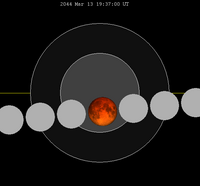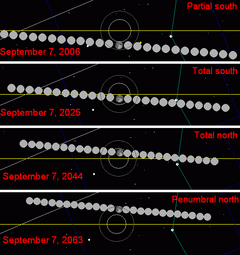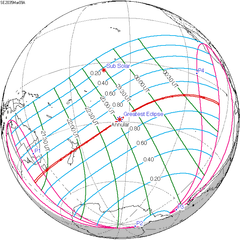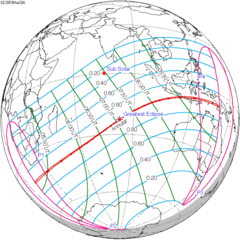March 2044 lunar eclipse
| Total eclipse | |||||||||||||||||
 The Moon's hourly motion shown right to left | |||||||||||||||||
| Date | March 13, 2044 | ||||||||||||||||
|---|---|---|---|---|---|---|---|---|---|---|---|---|---|---|---|---|---|
| Gamma | −0.3496 | ||||||||||||||||
| Magnitude | 1.2050 | ||||||||||||||||
| Saros cycle | 133 (28 of 71) | ||||||||||||||||
| Totality | 66 minutes, 25 seconds | ||||||||||||||||
| Partiality | 209 minutes, 5 seconds | ||||||||||||||||
| Penumbral | 338 minutes, 23 seconds | ||||||||||||||||
| |||||||||||||||||
A total lunar eclipse will occur at the Moon’s descending node of orbit on Sunday, March 13, 2044,[1] with an umbral magnitude of 1.2050. A lunar eclipse occurs when the Moon moves into the Earth's shadow, causing the Moon to be darkened. A total lunar eclipse occurs when the Moon's near side entirely passes into the Earth's umbral shadow. Unlike a solar eclipse, which can only be viewed from a relatively small area of the world, a lunar eclipse may be viewed from anywhere on the night side of Earth. A total lunar eclipse can last up to nearly two hours, while a total solar eclipse lasts only a few minutes at any given place, because the Moon's shadow is smaller. Occurring about 6.2 days after perigee (on March 7, 2044, at 15:30 UTC), the Moon's apparent diameter will be larger.[2]
This lunar eclipse is the third of a tetrad, with four total lunar eclipses in series, the others being on March 25, 2043; September 19, 2043; and September 7, 2044.
Visibility
[edit]The eclipse will be completely visible over east Africa, eastern Europe, and much of Asia, seen rising over west Africa, western Europe, and eastern South America and setting over northeast Asia and Australia.[3]
 
|
Eclipse details
[edit]Shown below is a table displaying details about this particular solar eclipse. It describes various parameters pertaining to this eclipse.[4]
| Parameter | Value |
|---|---|
| Penumbral Magnitude | 2.23223 |
| Umbral Magnitude | 1.20503 |
| Gamma | −0.34957 |
| Sun Right Ascension | 23h37m30.3s |
| Sun Declination | -02°25'56.9" |
| Sun Semi-Diameter | 16'05.4" |
| Sun Equatorial Horizontal Parallax | 08.8" |
| Moon Right Ascension | 11h36m51.3s |
| Moon Declination | +02°08'22.5" |
| Moon Semi-Diameter | 15'39.8" |
| Moon Equatorial Horizontal Parallax | 0°57'29.1" |
| ΔT | 81.5 s |
Eclipse season
[edit]This eclipse is part of an eclipse season, a period, roughly every six months, when eclipses occur. Only two (or occasionally three) eclipse seasons occur each year, and each season lasts about 35 days and repeats just short of six months (173 days) later; thus two full eclipse seasons always occur each year. Either two or three eclipses happen each eclipse season. In the sequence below, each eclipse is separated by a fortnight.
| February 28 Ascending node (new moon) |
March 13 Descending node (full moon) |
|---|---|
 |

|
| Annular solar eclipse Solar Saros 121 |
Total lunar eclipse Lunar Saros 133 |
Related eclipses
[edit]Eclipses in 2044
[edit]- An annular solar eclipse on February 28.
- A total lunar eclipse on March 13.
- A total solar eclipse on August 23.
- A total lunar eclipse on September 7.
Metonic
[edit]- Preceded by: Lunar eclipse of May 26, 2040
- Followed by: Lunar eclipse of January 1, 2048
Tzolkinex
[edit]- Preceded by: Lunar eclipse of January 31, 2037
- Followed by: Lunar eclipse of April 26, 2051
Half-Saros
[edit]- Preceded by: Solar eclipse of March 9, 2035
- Followed by: Solar eclipse of March 20, 2053
Tritos
[edit]- Preceded by: Lunar eclipse of April 14, 2033
- Followed by: Lunar eclipse of February 11, 2055
Lunar Saros 133
[edit]- Preceded by: Lunar eclipse of March 3, 2026
- Followed by: Lunar eclipse of March 25, 2062
Inex
[edit]- Preceded by: Lunar eclipse of April 4, 2015
- Followed by: Lunar eclipse of February 22, 2073
Triad
[edit]- Preceded by: Lunar eclipse of May 13, 1957
- Followed by: Lunar eclipse of January 13, 2131
Lunar eclipses of 2042–2045
[edit]This eclipse is a member of a semester series. An eclipse in a semester series of lunar eclipses repeats approximately every 177 days and 4 hours (a semester) at alternating nodes of the Moon's orbit.[5]
The penumbral lunar eclipse on October 28, 2042 occurs in the previous lunar year eclipse set.
| Lunar eclipse series sets from 2042 to 2045 | ||||||||
|---|---|---|---|---|---|---|---|---|
| Descending node | Ascending node | |||||||
| Saros | Date Viewing |
Type Chart |
Gamma | Saros | Date Viewing |
Type Chart |
Gamma | |
| 113 | 2042 Apr 05
|
Penumbral
|
1.1080 | 118 | 2042 Sep 29
|
Penumbral
|
−1.0261 | |
| 123 | 2043 Mar 25
|
Total
|
0.3849 | 128 | 2043 Sep 19
|
Total
|
−0.3316 | |
| 133 | 2044 Mar 13
|
Total
|
−0.3496 | 138 | 2044 Sep 07
|
Total
|
0.4318 | |
| 143 | 2045 Mar 03
|
Penumbral
|
−1.0274 | 148 | 2045 Aug 27
|
Penumbral
|
1.2060 | |
Metonic series
[edit]The Metonic cycle repeats nearly exactly every 19 years and represents a Saros cycle plus one lunar year. Because it occurs on the same calendar date, the Earth's shadow will in nearly the same location relative to the background stars.
|
|

|
Tritos series
[edit]The tritos series repeats 31 days short of 11 years at alternating nodes. Sequential events have incremental Saros cycle indices.
This series produces 23 total eclipses between June 22, 1880 and August 9, 2120.
| Ascending node | Descending node | |||||
|---|---|---|---|---|---|---|
| Saros | Date Viewing |
Type chart |
Saros | Date Viewing |
Type chart | |
| 120 | 1902 Apr 22
|
Total
|
121 | 1913 Mar 22
|
Total
| |
| 122 | 1924 Feb 20
|
Total
|
123 | 1935 Jan 19
|
Total
| |
| 124 | 1945 Dec 19
|
Total
|
125 | 1956 Nov 18
|
Total
| |
| 126 | 1967 Oct 18
|
Total
|
127 | 1978 Sep 16
|
Total
| |
| 128 | 1989 Aug 17
|
Total
|
129 | 2000 Jul 16
|
Total
| |
| 130 | 2011 Jun 15
|
Total
|
131 | 2022 May 16
|
Total
| |
| 132 | 2033 Apr 14
|
Total
|
133 | 2044 Mar 13
|
Total
| |
| 134 | 2055 Feb 11
|
Total
|
135 | 2066 Jan 11
|
Total
| |
| 136 | 2076 Dec 10
|
Total
|
137 | 2087 Nov 10
|
Total
| |
| 138 | 2098 Oct 10
|
Total
| ||||
Half-Saros cycle
[edit]A lunar eclipse will be preceded and followed by solar eclipses by 9 years and 5.5 days (a half saros).[6] This lunar eclipse is related to two annular solar eclipses of Solar Saros 140.
| March 9, 2035 | March 20, 2053 |
|---|---|

|

|
See also
[edit]References
[edit]- ^ "March 13–14, 2044 Total Lunar Eclipse (Blood Moon)". timeanddate. Retrieved 3 December 2024.
- ^ "Moon Distances for London, United Kingdom, England". timeanddate. Retrieved 3 December 2024.
- ^ "Total Lunar Eclipse of 2044 Mar 13" (PDF). NASA. Retrieved 3 December 2024.
- ^ "Total Lunar Eclipse of 2044 Mar 13". EclipseWise.com. Retrieved 3 December 2024.
- ^ van Gent, R.H. "Solar- and Lunar-Eclipse Predictions from Antiquity to the Present". A Catalogue of Eclipse Cycles. Utrecht University. Retrieved 6 October 2018.
- ^ Mathematical Astronomy Morsels, Jean Meeus, p.110, Chapter 18, The half-saros
External links
[edit]- 2044 Mar 13 chart: Eclipse Predictions by Fred Espenak, NASA/GSFC



